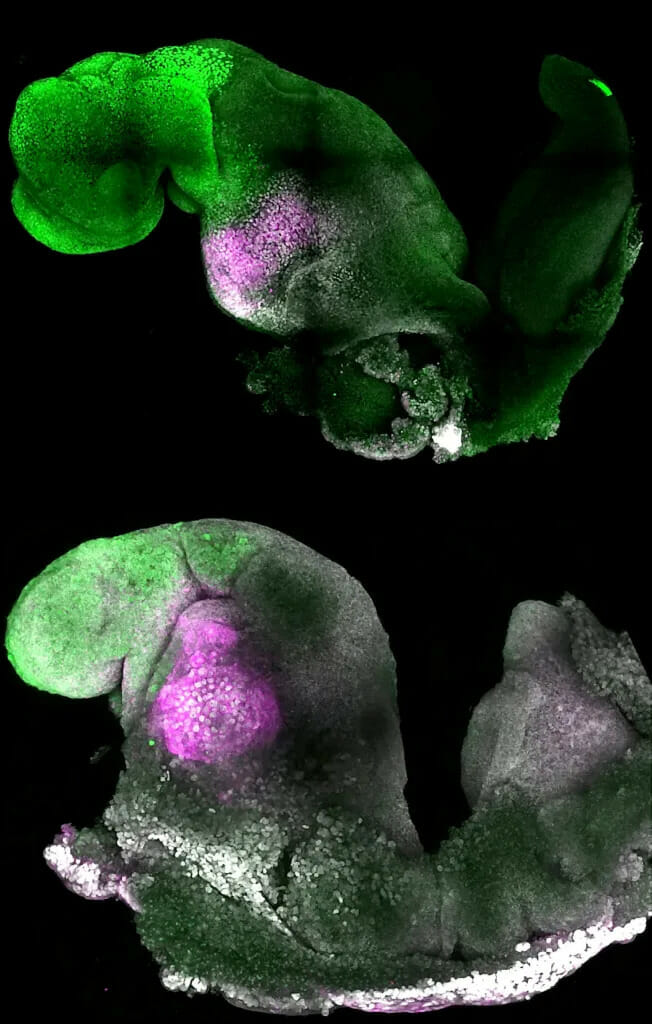Scientists from the University of Cambridge and Caltech have recently announced that they created a “synthetic” embryo with all the main functioning organs needed for life, including a beating heart, brain, intestines, along with ‘neural and gut tubes that protect the developing spine,’ according to Study Finds.
The team of international scientists used a combination of stem cells from mice without sperm or fertilized eggs.
The scientist’s creation eventually started to grow muscles, a nervous system, and an even a gut.
Our mouse embryo model not only develops a brain, but also a beating heart, all the components that go on to make up the body.
It’s just unbelievable that we’ve gotten this far. This has been the dream of our community for years, and the major focus of our work for a decade, and finally we’ve done it.
Lead study author Professor Magdalena Zernicka-Goetz
Study Finds explains the process in more detail:
Successful pregnancies need a “dialogue” between an embryo and mother. In the first week after fertilization, three types of stem cells develop.
One will eventually become the tissues of the body. The others support the embryo’s development. They become the placenta, which connects the fetus to the mother and provides oxygen and nutrients, and the yolk sac, where the embryo gets its nutrients and grows.
Each group has to send mechanical and chemical signals to each other, telling the embryo how to develop properly. Prof. Zernicka-Goetz notes that so many pregnancies fail during this stage, before most women realize they’re pregnant.
This early period is the foundation for everything else that follows in pregnancy. If it goes wrong, the pregnancy will fail.
Zernicka-Goetz says
The researchers mimicked natural processes in the lab by guiding three types of stem cells found in early mammalian development to the point where they start interacting. Inducing the expression of a particular set of genes and establishing a unique environment got them to “talk” to each other.
The model copies the stages of natural mouse embryo development that take place up to eight-and-a-half days after fertilization. Over the past decade, Prof. Zernicka-Goetz’s group has been studying these initial stages in order to understand why pregnancies sometimes go wrong.
The stem cell embryo model is important because it gives us accessibility to the developing structure at a stage that is normally hidden from us due to the implantation of the tiny embryo into the mother’s womb. This accessibility allows us to manipulate genes to understand their developmental roles in a model experimental system.
Study authors sparked development of their synthetic embryo by weaving together different cultured stem cells. They represented each of the three types of tissue in the right proportions and environment to promote growth and communication. After self-assembling into an embryo, the researchers found they signaled chemically, mechanistically, and through touch.
This period of human life is so mysterious, so to be able to see how it happens in a dish—to have access to these individual stem cells, to understand why so many pregnancies fail and how we might be able to prevent that from happening—is quite special. We looked at the dialogue that has to happen between the different types of stem cells at that time—we’ve shown how it occurs and how it can go wrong.
Zernicka-Goetz adds
A major advance is the ability to generate the entire brain, in particular the anterior — a big goal in the development of synthetic embryos. In Prof. Zernicka-Goetz’s system, this part requires messages from one of the extra-embryonic tissues to be able to develop.
This opens new possibilities to study the mechanisms of neurodevelopment in an experimental model.
In fact, we demonstrate the proof of this principle in the paper by knocking out a gene already known to be essential for formation of the neural tube, precursor of the nervous system, and for brain and eye development. In the absence of this gene, the synthetic embryos show exactly the known defects in brain development as in an animal carrying this mutation. This means we can begin to apply this kind of approach to the many genes with unknown function in brain development.

Currently researchers are now trying to replicate identical models for humans, opening the door for the specific creation of different organs, while also allowing for further study on the development and mechanics of different bodily functions.
There are so many people around the world who wait for years for organ transplants. What makes our work so exciting is that the knowledge coming out of it could be used to grow correct synthetic human organs to save lives that are currently lost. It should also be possible to affect and heal adult organs by using the knowledge we have on how they are made.
Zernicka-Goetz concludes
AUTHOR COMMENTARY
I’ve reported on the push and coming normalization of transhumanism coming down the pike, and it is certainly a sinister one indeed:
A Transhuman Future: Cloning Mankind, Man-Animal Hybrids, Cyborgs, And “Bio-Pharma”
The Satanic Rebirth And Growth Of Eugenics, Gene Selection, And Transhumanism
Scientists Are Creating Living Artificial Skin For Robots That Can Feel Pain
As can be seen by these scientist’s quotes, they are quite giddy that they have created and replicated a soulless life. These globalists and transhumanists – people like Yuval Harai, who openly mock the existence of a soul and spirit, that are just hackable creatures, and the “useless” people need to go bye-bye – seek to play God in their own mind, and be their own god, whilst furthering damming their conscience into believing that they have just proven Darwinian evolution.
[11] If thou forbear to deliver them that are drawn unto death, and those that are ready to be slain; [12] If thou sayest, Behold, we knew it not; doth not he that pondereth the heart consider it? and he that keepeth thy soul, doth not he know it? and shall not he render to every man according to his works?And the LORD God formed man of the dust of the ground, and breathed into his nostrils the breath of life; and man became a living soul.
Genesis 2:7
Man without a soul and a spirit is just an animated corpse, a zombie. The dead have created the dead.
[7] Who goeth a warfare any time at his own charges? who planteth a vineyard, and eateth not of the fruit thereof? or who feedeth a flock, and eateth not of the milk of the flock? [8] Say I these things as a man? or saith not the law the same also? [9] For it is written in the law of Moses, Thou shalt not muzzle the mouth of the ox that treadeth out the corn. Doth God take care for oxen? [10] Or saith he it altogether for our sakes? For our sakes, no doubt, this is written: that he that ploweth should plow in hope; and that he that thresheth in hope should be partaker of his hope. (1 Corinthians 9:7-10).
The WinePress needs your support! If God has laid it on your heart to want to contribute, please prayerfully consider donating to this ministry. If you cannot gift a monetary donation, then please donate your fervent prayers to keep this ministry going! Thank you and may God bless you.









One day, they’ll impart devils in them. They’ll be walking devils.
Totally agree
Just wanted to add that the first scripture quote is proverbs 24:11-12, which is not specified in the article.
[11] If thou forbear to deliver them that are drawn unto death, and those that are ready to be slain; [12] If thou sayest, Behold, we knew it not; doth not he that pondereth the heart consider it? and he that keepeth thy soul, doth not he know it? and shall not he render to every man according to his works?